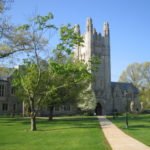Studying Bioengineering at UCLA: My Experience
What’s Covered:
- Declaring the Bioengineering Major at UCLA
- Requirements for the Bioengineering Major at UCLA
- Research Opportunities
- Course Structure and Advising
- What Are Your Chances of Acceptance at UCLA
I knew I wanted to help people through healthcare, but I also knew I wanted to study engineering. This led me to choose the bioengineering major. Bioengineering also allowed me to take the pre-med track to fulfill my original goal of becoming a doctor.
But, a few months into college, I realized I wanted to go into industry instead of medical school. I wanted to focus on circuitry in medical devices, so I debated for months about switching to Electrical Engineering. However, the broad realm of coursework as a bioengineering major as well as the opportunities bioengineers have at UCLA convinced me to stay as a bioengineering major with a focus in electrical engineering.
In this article, I will give insight into my experience as a bioengineering major at UCLA.
Declaring the Bioengineering Major at UCLA
When applying to The Henry Samueli School of Engineering and Applied Sciences at UCLA, you apply to the specific engineering major of your choosing (check out the Technical Breadth section to find out more). You may also choose to apply as an undeclared engineering major in which you declare your engineering major during your college career. Regardless of which major you apply for, your choice of major does not impact your admission chances.
When you want to declare your major (if you get accepted as undeclared engineering) you can do so by contacting the engineering department’s Office of Affairs and Student Advising (OASA). This must be done between the Winter Quarter of your freshman and sophomore year. Furthermore, you must have at least a 2.7 GPA in the engineering preparatory classes at the time of your major declaration.
If you want to change engineering majors at any point during your college career, you can do so but only once. You are also required to have completed a minimum of two quarters at UCLA and must change your major before your third year.
It’s important to note that bioengineering is a very broad major. You can take so many different approaches to bioengineering like: tissue engineering, drug delivery, protein synthesis, pharmaceuticals, medical devices, the list goes on! Your major and the opportunities you’ll have in the future is heavily dependent on the courses you choose to take, what you choose to specialize in and what interests you the most. For example, as a bioengineer, I was interested in the medical device track, which is why I took more classes relating to electrical engineering and less related to bioconjugation.
Requirements for the Bioengineering Major at UCLA
There are four types of requirements needed to complete your bioengineering major at UCLA: introductory courses, general elective courses, major-required courses, and bioengineering electives.
Introductory courses are lower division classes that prepare you for upper division courses. These include courses related to physics, math, chemistry and biology and some classes such as Math 31 may be passed off with AP Courses. A complete list is given below:
- Introduction to Bioengineering
- Calculus (Satisfied with Calc BC AP Scores)
- Calculus of Several Variables
- Linear Algebra
- Differential Equations
- Mechanics
- Oscillation and Waves and Fields
- Electrodynamics and Optics
- Mechanics Lab
- General Chemistry
- Organic Chemistry
- Cellular and Molecular Biology
- Physiology and Human Biology
- Intro to Computer Science or MATLAB Programming (only one of these needs to be taken)
General electives are courses that introduce you to diverse perspectives so that you can learn new concepts not related to your major. Engineering majors are expected to take four general elective courses that cover topics in art, humanities and social sciences. If you’re interested in some types of GEs offered at UCLA, here is a list of some I have taken:
- Musicology: The Beatles
- Philosophy: Morals and Ethics
- Gender Studies: Gender, Sex and Sexuality
- African American Studies: An introduction
Upper division courses that are particular to your major are divided into two types of courses: Major Required Courses and Electives, which we will delve into in the next section.
Bioengineering Major-Required Courses at UCLA
Bioengineering Major-Required courses are classes that all bioengineering students must take regardless of their interests. The following is a complete list of the major required courses offered to bioengineering majors at UCLA:
- Bioengineering 100: Bioengineering Fundamentals: This is probably the hardest class you will take at UCLA (and unluckily, it’s also the first upper division class you will take). This class is taught by Dr. Daniel Kamei who is a distinguished professor and is known for his research in novel care points of diagnostics. This class focuses heavily on the fundamentals of classical and statistical thermodynamic analysis of biological systems (I’m sure you can tell how hard the class is through that sentence). However, it’s also one of the most rewarding classes you will take and Dr. Kamei knows just how to teach to prepare you for all of his exams.
- Bioengineering 110: Biotransport and Bioreaction Processes: This class is a continuation of BE 100 and focuses on the analysis of fluid flow, heat and mass transfer, binding events as well as biochemical reactions in cells, tissues, organs, the human body, bioartificial organs and more.
- Bioengineering 120: Biomedical Transducers: This may have been my favorite upper division course at UCLA. As someone who loves circuitry and learning about medical devices, I had a lot of fun learning about the principles of transduction, data processing and recording microfabricated and nanofabricated sensors.
- Bioengineering 167L: Bioengineering Lab: UCLA Bioengineering requires you to take one bioengineering related lab course that gives you both a theoretical and hands-on approach to laboratory skills. You’ll learn how to conduct experiments through cell culture, bioconjugation, fluorescence and will actually put these skills to use. Moreover, you will expand on your technical writing ability through lab reports and presentations.
- Bioengineering 176: Principles of Biocompatibility: This class discusses biocompatibility at the tissue, cellular and molecular levels of the body.
- Bioengineering 177A/B: Capstone Design: This class is a two quarter course taken your senior year in which you are working with five to six other students to innovate solutions either through biomedical devices or therapeutic design to address current medical problems. The course culminates in a symposium in which teams compete to determine the best project.
- Bioengineering 180: Systems Integration in Biology, Engineering and Medicine: If you want to become a doctor or are pre-med, this class will help you in the long run. You’ll gain a molecular understanding of how the cardiovascular, pulmonary and renal system work both independently and dependently. The course further discusses fundamental engineering principles related to the body.
- Electrical Engineering 100: Electrical and Electronic Circuitry: All bioengineering majors are expected to take an introductory electrical engineering course. This course will give you insight into another major at UCLA.
- Engineering 183: Engineering Ethics: All engineering majors at UCLA are required to take a technical writing course since engineering isn’t just about the numbers or device design. Engineers in industry and research are expected to be able to communicate their thoughts through reports and research papers. Engineering Ethics further educates you about the ethical limits of engineering.
Bioengineering Major Electives at UCLA
Aside from the major required courses bioengineering majors must take at UCLA, you are required to take six additional courses in bioengineering. However, you are allowed to pick which courses you want to take from a large list to satisfy your interests. Here are some of the options available for students:
- Bioengineering 121: Introduction to Microcontrollers: As an enthusiast of circuits and devices, BE 121 is probably my favorite BE elective at UCLA. Dr. Schmidt provides you with a hands-on course in which you utilize microcontrollers and an Arduino Uno to create projects related to robots, motion, sensing and data acquisition and more. You will also learn how to create cool Graphical User Interfaces (GUI) through a software known as processing.
- Bioengineering C147: Applied Tissue Engineering – Clinical and Industrial Perspective: This class is unique because you get to listen to people working in industry and see what they are currently working on. You also get an overview of tissue engineering and focus on learning how to build artificial tissues to incorporate them in clinically viable products.
- Bioengineering C175: Machine Learning and Data-Driven Modeling in Bioengineering: If you are interested in taking the computer programming route in bioengineering, C175 is a class you’re going to want to take. Dr. Meyer will teach you how to utilize data analysis and machine-learning to interpret experimental observations.
- Bioengineering M182: Dynamic Biosystem Modeling and Simulation Methodology: This class is a favorite amongst many bioengineering majors. This course is oftentimes an easy A and gives students an introduction to explicit modeling of biological systems through a software known as Simulink.
- Bioengineering 199: Directed Research in Bioengineering: If you are in a research lab, you can get up to 8 units of credit for conducting research under a faculty mentor. The only thing required to pass this course is a written, culminating paper to prove that you effectively conducted research over a quarter.

Research Opportunities as a Bioengineering Major
As you can see, Bioengineering 199 gives undergraduates the opportunity to participate in research while getting course credit for their work. Joining a research lab at UCLA is very easy if you are passionate about doing so. The research lab you choose to work for doesn’t even have to be in bioengineering or even in engineering all together!
I joined an electrical engineering research lab with a bioengineering emphasis the spring of my freshman year. I have worked in Dr. Ozcan’s Lab-on-a-Chip lab and loved every moment of it! When you feel the time is right and you think you will be able to handle an additional load (most labs require you work a maximum of 10 hours in their lab), reach out to professors whose work interests you. Send them an email emphasizing your interest (do your research about their work so you can drop some information about how you know what goes on in their lab) and attach a resume at the bottom of the email. Hopefully, the professor or a grad student who works in the lab will respond to you with an invitation for an interview to see if you will be a good fit. When I was looking for a lab to work in, I skimmed this pdf to find professors within the engineering department whose work I was interested in joining.
Bioengineering Course Structure and Advising at UCLA
At UCLA, lower division courses are oftentimes one hour lectures that occur three days a week with a one hour discussion section. Upper division engineering classes are oftentimes two hour lectures that happen twice a week with a weekly two hour discussion section. If you are new to the concept of a discussion section, this is just a chunk of time in which a Teacher’s Assistant (who is usually a graduate student) covers topics that were discussed by the professor in lecture to make sure the information is really drilled into your brain. These classes are much smaller than the lecture size to ensure that students get personal attention.
Advising is heavily emphasized by the Henry Samueli School of Engineering and Applied Sciences. The school offers two types: Counseling through OASA – organized through the school of engineering – allows you to talk to school counselors who will make sure you are on track to graduate with good grades, and faculty advising, which is more specific to your department. When you enroll as a freshman, you will be “assigned” to a professor. This allows you to develop an intimate connection with at least one professor at the school and also provides you with more specialized advice specific to bioengineering.
Engineering Technical Breadth
At UCLA, engineers only have two available options for minoring: Bioinformatics and environmental engineering. It is required to “minor” in another engineering major, which is called the engineering tech breadth requirement. Students must take at least three courses in another engineering field.
The following are other engineering majors offered at UCLA. You can also do your tech breadth in these fields:
- Aerospace Engineering
- Chemical Engineering
- Civil Engineering
- Computer Engineering
- Computer Science and Engineering
- Computer Science
- Electrical and Computer Engineering
- Materials Engineering
- Mechanical Engineering
As I mentioned earlier, I got my technical breadth in electrical engineering. This has proven beneficial to me because I started applying to internships for electrical engineering positions at biotech companies. Companies loved hearing that as an engineering major, I was interested in other fields aside from my major. This made me a competitive candidate for numerous internship positions in biotech. Once I graduate, I will be working as an electrical engineer at Medtronic, one of the largest medical device companies in the world.
The Biomedical Engineering Society at UCLA
The Biomedical Engineering Society at UCLA is a great resource for bioengineers. The club allows students to get direct connections to biotech industry representatives and provides a meaningful mentorship program with upperclassmen to make sure underclassmen are prepared to succeed during college. The club also provides resources for UCLA bioengineering alumni. Students also have access to a technical project program where you can get cell-based lab training (which will be useful when applying to bioengineering research labs).
Studying Abroad as a Bioengineering Major at UCLA
Studying abroad as an engineering major is easy if you are able to plan ahead. UCLA has specific requirements for studying abroad and during COVID, the school is even offering virtual study abroad programs. It is also especially important to plan as early as you can so that you don’t miss out on opportunities e.g. realizing your junior year you could have taken lower division classes abroad (can you tell that I’m still upset?).
Taking lower division courses such as physics, tech breadth classes, or general electives abroad will probably be the easiest classes to find availability for in other cities such as London, Brussels and Copenhagen.
As you plan, you can reach out to both OASA and the International Educator Office. The engineering department’s OASA can help you determine how to structure your four year plan accordingly to make studying abroad possible while the International Educator Office can help answer all study abroad needs.
What Are Your Chances of Acceptance at UCLA
Many students apply to UCLA, which means the school’s acceptance rate is relatively low (roughly 14%). However, your personal chances of getting in could be higher or lower based on your application.
To better understand your chances at UCLA, we recommend using our free admissions calculator. After you input your grades, test scores, and extracurriculars, you’ll get an estimate of your odds of acceptance. CollegeVine even provides you with tips on improving your profile.



